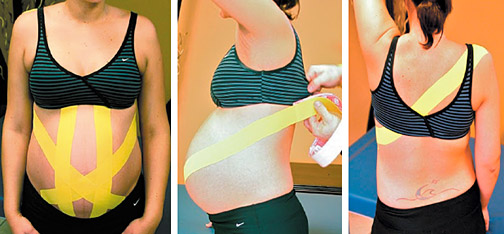Pregnant women are frequently at a loss for answers with respect to pain associated with their growing abdomen.
Unfortunately, the nonelastic qualities of this type of tape often result in skin irritation. In addition, taping with conventional athletic tape typically will only last a day at best, which does not provide long-lasting relief. It is clear that this population is desperately seeking a comfortable, cost-effective, skin-sparing postural correction system that will provide pain relief for multiple days and nights.
The "baby belt" taping application can provide the long-lasting custom support pregnant women need. Elastic therapeutic tape is applied not to individual muscle groups, but instead along fascial vector lines to aid in reducing a variety of aches and pains associated with pregnancy. Proper taping methods can help alleviate neck-related postural stress, lower back pain, sacroiliac pain and perhaps most importantly, pain attributable to the additional weight of the growing abdomen. This taping application offloads the anterior carriage system (growing abdomen) by redistributing the stress to the upper scapulothoracic region via the "spiral and superficial front lines," a fascial sling described by Thomas Myers in Anatomy Trains: Myofascial Meridians for Manual and Movement Therapists (2009).
The fascial system has been revisited in the past 10 years by Myers and other experts, including Luigi Stecco, Robert Schleip and Gil Hedley. Dr. Schleip, a German fascial researcher, described fascia as the "Cinderella of body tissues," as it was systematically dissected out in an attempt to expose underlying muscle/organ tissue. In so doing, it developed generations of tissue-specific practitioners and techniques that excluded fascia as an important structure. By taping fascial continuities, the value of the fascial system became apparent, potentially through improving communication proprioceptively along these kinetic chains.

So, how can tape applied directly to the skin affect the fascial system? Dr. Hedley, a renowned fascial anatomist, has stated that "the skin is the skin of the superficial fascial layer" and that when you distort one, the other is affected as well. With respect to taping, Hedley and other fascial innovators contend that stimulation of the skin enhances fascial proprioception.
The fascial system encompasses all, from skin to core, hooking tissues together through what the fascial community likes to call the "neuromyofascial web." A growing body of evidence suggests that the fascial system is 10 times more proprioceptive-rich in sensory function, providing the brain with augmented mechanoregulation (kinesthetic awareness). If this is true, elastic therapeutic tape applied to the skin can create a shearing effect to the underlying subdermal/superficial fascia layer, creating a stimulatory effect on a greater amount of sensory receptors that enhance body kinesthesia, and in turn, improve body postural positioning. For our pregnant patients, proper taping procedures can alleviate postural strain on vulnerable segments of their bodies, including the inguinal region, lower back, cervicothoracic junction and pubic symphysis, which can positively affect associated pain syndromes.
Resources
- Fuller RB. Synergetics. New York: Macmillan, 1975.
- Ingber D. Tensegrity and mechanotransduction. Journal of Bodywork and Movement Therapies, 2008;12(3):198-200.
- Second International Fascia Research Congress, 2009. www.fasciacongress.org/2009
- Myers TW. Anatomy Trains: Myofascial Meridians for Manual and Movement Therapists. New York: Churchill-Livingston, 2009.
- Schleip R. Fascial plasticity - a new neurobiological explanation. Journal of Bodywork and Movement Therapies, 2003. Part 1;7(1):11-19; part 2;7(2):104-16.
Dr. Steven Capobianco, a self-described "fascial geek," operates a private sports practice in Los Gatos, Calif., and is an adjunct instructor at Palmer College of Chiropractic West, teaching portions of the sports chiropractic elective program. Dr. Capobianco is also vice president of medical operations at Rocktape, Inc. (www.rocktape.com).




